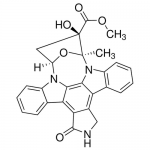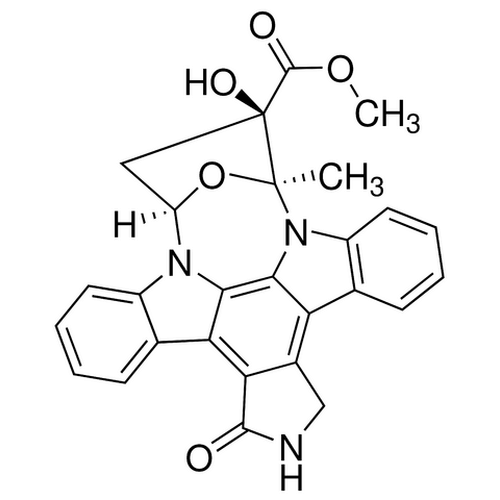| Product Name | K252A |
| Description |
Kinase inhibitor |
| Purity | >98% (HPLC) |
| CAS No. | 99533-80-9 |
| Molecular Formula | C27H21N3O5 |
| Molecular Weight | 467.5 |
| Field of Use | Not for use in humans. Not for use in diagnostics or therapeutics. For in vitro research use only. |
Properties
| Storage Temperature | -20ºC |
| Shipping Temperature | Shipped Ambient |
| Product Type | Inhibitor |
| Solubility | Soluble to 25 mM in DMSO |
| Source | Nonomuraea longicatena |
| Appearance | White solid |
| SMILES | [N]47C1=C(C6=C(C2=C1[N](C3=CC=CC=C23)[C@@H]5O[C@]4(C(C5)(O)C(=O)OC)C)C(NC6)=O)C8=C7C=CC=C8 |
| InChI | InChI=1S/C27H21N3O5/c1-26-27(33,25(32)34-2)11-18(35-26)29-16-9-5-3-7-13(16)20-21-15(12-28-24(21)31)19-14-8-4-6-10-17(14)30(26)23(19)22(20)29/h3-10,18,33H,11-12H2,1-2H3,(H,28,31)/t18?,26-,27-/m1/s1 |
| InChIKey | KOZFSFOOLUUIGY-CYBHFKQVSA-N |
| Safety Phrases |
Classification: Not a hazardous substance or mixture. Safety Phrases: S22 - Do not breathe dust. S24/25 - Avoid contact with skin and eyes. S36/37/39 - Wear suitable protective clothing, gloves and eye/face protection. |
| Cite This Product | K252A (StressMarq Biosciences Inc., Victoria BC CANADA, Catalog # SIH-455) |
Biological Description
| Alternative Names | (9S,10R,12R)-2,3,9,10,11,12-Hexahydro-10-hydroxy-9-methyl-1-oxo-9,12-epoxy-1H-diindolo[1,2,3-fg:3',2',1'-kl]pyrrolo[3,4-i][1,6]benzodiazocine-10-carboxylic acid methyl ester |
| Research Areas | Apoptosis, Cancer, Cancer Growth Inhibitors, Cell Signaling, Tyrosine Kinase Inhibitors |
| PubChem ID | 11612445 |
| Scientific Background | K252A is a broad-spectrum protein kinase inhibitor that targets a wide range of kinases, including PKA, PKC, PKG, CaM kinase II, myosin light chain kinase (mlCK), and receptor tyrosine kinases. In neuroscience, K252A is widely used to study neurotrophic signaling, particularly through its inhibition of TrkA, the receptor for nerve growth factor (NGF). It is employed in models of neuronal differentiation, survival, and synaptic plasticity. K252A is also used to investigate the role of kinase signaling in neurodegenerative processes and to explore therapeutic strategies targeting kinase dysregulation in the brain. |
| References |
1. Morotti A., Mila S., Accorner, P., Tagliabue E., & Ponzetto C. (2002) Oncogene. 21(32): 4885–4893. 2. Hashimoto Y., et al. (1991) Biochem. Biophys. Res. Comm. 181(1): 423–429. 3. Raychaudhuri S.P., Sanyal M., Weltman H., & Kundu-Raychaudhuri S. (2004) J. Invest. Derm. 122(3): 812–819. |



Reviews
There are no reviews yet.